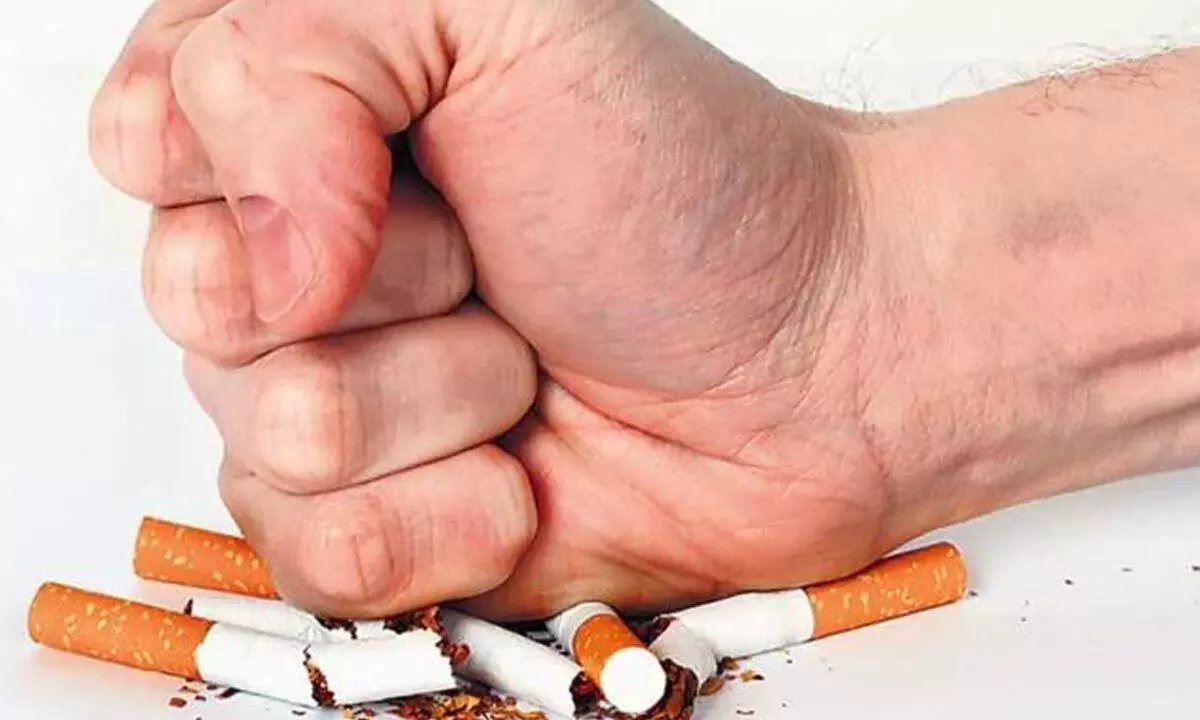Live
- All you need to know about PAN 2.0
- Akasa Air redefines travel experience with industry-first offerings
- MP: Residents stage protests against liquor shop in Indore
- Telugu Actor Shri Tej Booked for Alleged Cheating and False Promise of Marriage in Live-in Relationship
- Toyota Kirloskar Motor Celebrates 1 Lakh Urban Cruiser Hyryder on Indian Road
- MLS: New York City FC part ways with head coach Nick Cushing
- Delhi CM says Centre cutting AAP voters’ names from rolls, BJP hits back
- Hyderabad Metro Rail Phase-II Works to Begin in Old City in January 2025
- Odisha: 668 persons killed in human-elephant conflicts in last three years
- DEFENDER JOURNEYS: TO EMBARK ON ITS THIRD EDITION FROM NOVEMBER 2024
Just In
Urgent need to disincentivise tobacco consumption


Urgent need to disincentivise tobacco consumption
- The Lancet report says tobacco use is the risk factor for about 14 types of cancers. Besides tobacco being a preventable risk factor, most people affected by cancer report it at a later stage
- If the current trend continues, it will cost India 126 trillion rupees (roughly 2.3 trillion USD) by 2030, an amount that is 1.5 times India’s annual aggregate income and almost 35 times India’s total annual health spending
India started observing National Cancer Awareness Day since 2014 on 7th November. Apparently, 7th November coincides with the birth anniversary of the Nobel Prize winning scientist Madame Curie. Her contribution to the treatment of cancer by discovering radium and polonium earned her the prestigious noble prize.
In the month of February, Union government informed Lok Sabha that more than 40 lakh cancer cases were reported of whom 22.54 lakh people died of cancer between 2018-2020. According to a study report by Lancet, cancer is the second biggest killer, heart diseases occupy the first place. According to the experts' 70 of these cancers are preventable of which 40% are tobacco-related, 20% infection-related and 10% are due to other factors.
The Lancet report says tobacco use is the risk factor for about 14 types of cancers. Besides tobacco being a preventable risk factor, most people affected by cancer report it at a later stage. Therefore, the National Cancer Day observation is used to emphasize creating awareness on prevention and early identification.
The Parliamentary Standing Committee on Health and Family Welfare presented to the Chairman, Rajya Sabha the 139th report on "Cancer Care Plan & Management: Prevention, Diagnosis, Research and Affordability of Cancer Treatment" on 12th September 2022. The committee observed that tobacco is a major risk factor for cancer and said that nearly 50% of all cancers in India are due to tobacco. The committee insisted that to check the growing incidence of cancer in India, the consumption of tobacco should be disincentivised. The committee was convinced of the fact that tobacco use is initiated in teenage when teenagers are not yet mature to take rational decision making. When tobacco products are glamorized onscreen by celebrities supported by easy accessibility it encourages young people to explore them. The committee further noted that the cost of tobacco products in India is the lowest, therefore it recommended an increase of tax on all tobacco products as it not only prevents easy initiation but also the additional revenue generated as tax could be used for preventive programs.
The committee also believes that to achieve the Sustainable Development Goal (SDG) target, the Ministry of Health and Family Welfare must take effective measures to contain the sale of tobacco products. It recommends the government to abolish designated smoking areas in airports, hotels, and restaurants and encourage a smoke free policy in organizations. It further recommends the government to prohibit single stick sales of cigarettes and lay stringent penalties and fines on offenders. All these major recommendations are part of the COTPA amendment bill and we urge the Union Health Minister Dr Mansukh Mandaviya and Prime Minister Mr Narendra Modi to pass the bill at the earliest.Finally, the committee noted an important issue in tobacco control, nearly 80% of tobacco used is in the form of chewing. The committee recommended measures such as banning the sale of gutkha and prohibiting the advertisement of chewing tobacco products and pan masala to combat the aggressive marketing strategies used by the tobacco industry. The committee concluded that the above measures would help the government to keep up its commitment of the goal stated in the National Health Policy 2017 to reduce the prevalence of tobacco use by 30% in 2025. A World Health Organisation report says if the political commitment continues as it is being done, India is likely to achieve the 30%. But the trends in Non-communicable Diseases (NCDs) could pose a challenge to achieving the goal. A Harvard School of Public Health report cautioned in 2012 that if the current trend in NCDS continues, it will cost India 126 trillion rupees (roughly 2.3 trillion U.S. dollars) by 2030, an amount that is 1.5 times India's annual aggregate income and almost 35 times India's total annual health spending. Tobacco use is identified as a major preventable risk factor for NCDs.
More than 50% of India's current population is below the age of 25 and over 65% below the age of 35. It is this population that is succumbing to NCDs. The 50% of the population is the target of tobacco companies. Further substance abuse among this age group too is of great concern and tobacco use is identified as a gateway to drugs. If India needs to reduce the huge burden on NCDs, protecting young people from being initiated into tobacco use then, strengthening COTPA and hiking the tax on tobacco must be its highest priority besides the focus on other modifiable risk factors.
(The author is oncologist and President of Consortium for Tobacco Free Karnataka)

© 2024 Hyderabad Media House Limited/The Hans India. All rights reserved. Powered by hocalwire.com






